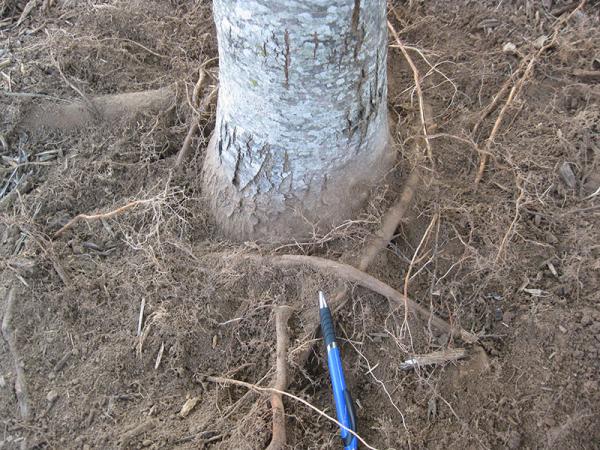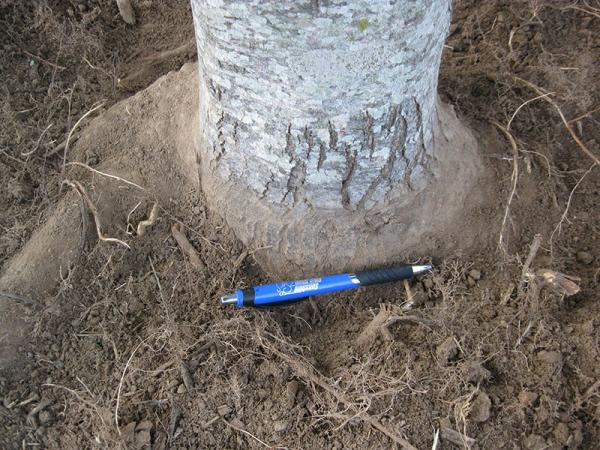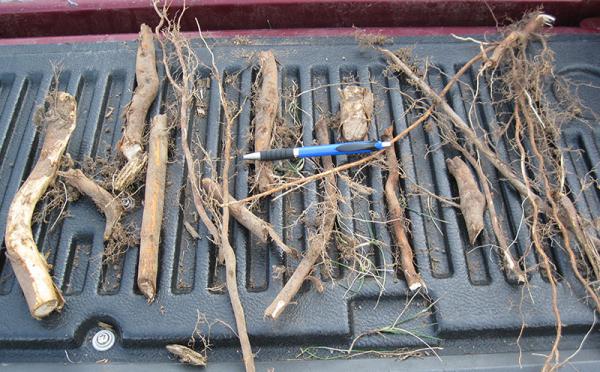Stem Girdling Roots (SGRs)
I have planted hundreds of trees in my career. Actually I think there is a real possibility I have planted in the thousands. Not multiple thousands mind you, but more than one thousand. I have also had to take care of those trees for many years after installation, and have had an opportunity to track many successes and some failures. My survival rate for the trees I have installed is very good, over 95%. Also as an ISA Certified Arborist, I have to study about tree culture, and am ethically bound to do industry best for them. What I have found over the years is that there are several surefire ways to plant a tree to die, one of which is stem girdling roots, or SGRs.
SGR Defined
An SGR is a root that has been deflected and is now growing in a circle around the tree trunk. Healthy roots should grow like a spoke away from the tree and into the surrounding soil. One of the main causes of SGRs is container-grown stock. The root hits a plastic wall, turns, then continues to grow in a circle. These roots will continue to grow like this even when removed from the container. As the tree trunk and roots grow occupying the same space, the roots constrict the enlargement of the trunk and begin girdling the vascular tissue of the trunk (directly below the outer bark). Many people think the trunk will grow to snap the root, however the roots are enlarging simultaneously.

Obvious SGRs that require pruning/removal.
The result
The result of a significant SGR is the trunk and root flare below the girdling does not enlarge. The trunk above the girdling does. This imbalance disrupts the normal taper and ultimately the tree either dies from insufficient water and food movement, or breaks at the point of girdling when under load. At the very least, the tree is stressed even under good conditions and is susceptible to secondary problems like disease or insect. The aesthetic appearance of the tree will suffer. Girdled trees will appear stunted, have sparse growth, poor coloration and flagging. Frequently, premature death of the tree occurs just when it should be coming into young maturity, and the death leaves a significant and noticeable void in the landscape.
Control
There are a number of steps to prevent or repair SGR that are easy to accomplish. Like many horticulture problems, prevention is frequently easier than repair.
Purchase good stock
Purchasing tree (and large shrub) stock without SGRs is your best defense. It is also the easiest since someone else is doing the work. Unfortunately most large scale, economical production methods used by nurseries can create SGRs. Inspect stock before accepting and be sure to examine root structure before you buy. This goes for container grown, balled & burlapped, or even spaded trees (trees may have SGRs prior to moving).
Address SGRs before you plant
The time to perform preventative pruning is before the tree goes in the hole. Examine the roots when you take the tree out to plant. Look for the root flare zone. The flare zone is where the primary buttress roots will widen quickly. Trace these roots away from the trunk and look for roots that cross them. If there are any cut the crossers with pruners. Be careful to prune small crossing roots and not the primary roots themselves. Aggressively tear open the roots by hand or with a pick. Try to separate the tangles of roots to guide them out from the trunk. Slicing the root bound area can be a last resort, but the roots should still be significantly pulled apart.
Plant at the right depth and do not over-mulch
The root flare zone should be obvious and should be planted above the soil level. A larger tree, greater than 4-6 inch caliper, should have a flare zone 2-3 times the width of the trunk. Do not mulch close to the tree, nor too thickly. Adventitious roots can grow aggressively in the mulch.
Curative
Existing trees in the landscape should be evaluated for SGRs. Smaller trees should be inspected first. Excavation of the root flare at ground level will quickly show if SGRs are present. Undesirable, inferior roots should be pruned. It is only necessary to remove a piece to prevent regrafting. A hand pick or bull trowel should suffice. This is examination, not major excavation. If you have high value trees the use of an air spade to blow soil from the root zone may be justifiable.

SGRs after root pruning.

A tailgate full of SGRs after removal.
Putting SGRs behind you
SGRs are a common problem. Yet I only learned about them in the last 10 years. The many trees I planted prior to this awareness survived because I aggressively separated roots to prevent circling. Preventing circling roots and preventing SGRs are two sides of the same coin. With a large dose of preventative effort, and a small dose of cure, SGRs can be overcome.



2 Comments
Recommended Comments